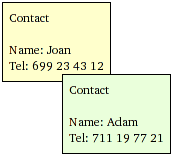Kexi/Handbook/Introduction to Databases/What Is a Database?: Difference between revisions
m (add formatting) |
(Marked this version for translation) |
||
| (6 intermediate revisions by 3 users not shown) | |||
| Line 1: | Line 1: | ||
<languages/> | |||
<translate> | |||
===What Is a Database?=== <!--T:1--> | |||
<!--T:2--> | |||
You can define a database as a collection of data on one topic. It is organised in a way allowing to easily browse the information, make changes or add new items. | You can define a database as a collection of data on one topic. It is organised in a way allowing to easily browse the information, make changes or add new items. | ||
<!--T:3--> | |||
Look at this diagram for one of the above examples: a simple phone book. | Look at this diagram for one of the above examples: a simple phone book. | ||
---- | </translate> | ||
----<translate> | |||
<!--T:10--> | |||
[[Image:contact-example.png|172px|center]] | [[Image:contact-example.png|172px|center]] | ||
---- | </translate> | ||
----<translate> | |||
<!--T:11--> | |||
The above picture shows a set of two contacts each of which is presented on a separate card. It appears that such a card can constitute a single row in a table: | The above picture shows a set of two contacts each of which is presented on a separate card. It appears that such a card can constitute a single row in a table: | ||
<!--T:4--> | |||
{|class="tablecenter" style="border: 1px solid grey;" | {|class="tablecenter" style="border: 1px solid grey;" | ||
|+ ''Contacts table'' | |||
! '''Name''' !! '''Tel No.''' | ! '''Name''' !! '''Tel No.''' | ||
|- | |- | ||
| Line 19: | Line 27: | ||
|} | |} | ||
Terms and definitions: A single data which constitutes a part of a greater collection can be called a ''row'' or more professionally a ''record''. The collection is normally called a ''table''. Moreover, the most natural name for the table is one describing the data it offers/stores which is Contacts. Furthermore, each row in the table consists of columns often also called ''fields''. In the table Contacts there are two columns (fields): Name and Tel No.. | <!--T:5--> | ||
Terms and definitions: A single data which constitutes a part of a greater collection can be called a ''row'' or more professionally a ''record''. The collection is normally called a ''table''. Moreover, the most natural name for the table is one describing the data it offers/stores which is Contacts. Furthermore, each row in the table consists of columns often also called ''fields''. In the table '''''Contacts''''' there are two columns (fields): '''Name''' and '''Tel No.'''. | |||
<!--T:6--> | |||
For simple uses a single table can make up a database. Many people consider these two equivalent. As you will see, for real databases we usually need more than one table. | For simple uses a single table can make up a database. Many people consider these two equivalent. As you will see, for real databases we usually need more than one table. | ||
To sum up, you have already got a simple database with one table '''Contacts'''. | <!--T:7--> | ||
To sum up, you have already got a simple database with one table '''''Contacts'''''. | |||
<!--T:12--> | |||
{{Note|1=Check content at [https://www.zoho.com/creator/database-software-vs-spreadsheet.html www.zoho.com/creator/database-software-vs-spreadsheet.html]}} | |||
<!--T:8--> | |||
{{Prevnext2 | |||
|prevpage=Special:MyLanguage/Kexi/Handbook/Appendix_A._Introduction_to_Databases | |||
|prevtext=Appendix A. Introduction to Databases | |||
|nextpage=Special:MyLanguage/Kexi/Handbook/Introduction_to_Databases/Database_and_Spreadsheet | |||
|nexttext=Database and Spreadsheet | |||
|index=Special:MyLanguage/Kexi/Handbook|indextext=Back to menu | |||
}} | |||
<!--T:9--> | |||
[[Category:Kexi]] | |||
[[Category:Tutorials]] | |||
</translate> | |||
Latest revision as of 17:01, 7 April 2012
What Is a Database?
You can define a database as a collection of data on one topic. It is organised in a way allowing to easily browse the information, make changes or add new items.
Look at this diagram for one of the above examples: a simple phone book.

The above picture shows a set of two contacts each of which is presented on a separate card. It appears that such a card can constitute a single row in a table:
| Name | Tel No. |
|---|---|
| Joan | 699 23 43 12 |
| Adam | 711 19 77 21 |
Terms and definitions: A single data which constitutes a part of a greater collection can be called a row or more professionally a record. The collection is normally called a table. Moreover, the most natural name for the table is one describing the data it offers/stores which is Contacts. Furthermore, each row in the table consists of columns often also called fields. In the table Contacts there are two columns (fields): Name and Tel No..
For simple uses a single table can make up a database. Many people consider these two equivalent. As you will see, for real databases we usually need more than one table.
To sum up, you have already got a simple database with one table Contacts.

